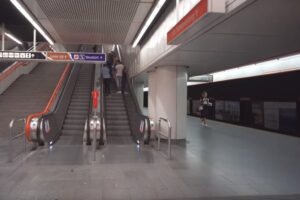ENERGY FROM METRO BRAKES
In the course of the project, a pilot system will be used to determine how to use the energy generated from metro brakes more efficiently. The energy will be used in the metro stations for elevators, lighting and escalators and will reduce energy consumption sustainably. The tests were successfully completed in January 2018.
 Almost all metros and trams of Wiener Linien already possess the ability to recover the energy of movement (braking energy) as electric energy when braking the train, and to feed it back to the direct current power system. This energy can be used by a train in the nearest environment for acceleration. If there is no vehicle in the vicinity of the regenerative vehicle, the energy is converted into heat in the brake resistors of the train.
Almost all metros and trams of Wiener Linien already possess the ability to recover the energy of movement (braking energy) as electric energy when braking the train, and to feed it back to the direct current power system. This energy can be used by a train in the nearest environment for acceleration. If there is no vehicle in the vicinity of the regenerative vehicle, the energy is converted into heat in the brake resistors of the train.
The aim of the project is to test in a pilot system how to more efficiently use the accumulated energy from braking a metro train. By feeding the braking energy into the medium voltage grid, energy consumption should be reduced sustainably. The previously unused brake energy is intended to provide support to consumers in the subway stations (e.g., elevators, escalators). The pilot plant was installed on September 19, 2016.
Public transport makes a significant contribution to the quality of life in Vienna. The energy intensity of transport, however, obliges energy efficiency. Right now, the share of the electricity consumption of the metro in the total electricity consumption of Wiener Linien is about 40%. This is about 170 GWh per year, which corresponds to the annual consumption of about 50,000 Viennese households. This project will improve the energy efficiency of metro operation. This results in energy savings and a corresponding reduction in CO2 emissions. The project also has an economic benefit for the Wiener Linien as the energy costs of the metro – a significant cost center of the company’s expenses – can be reduced.


